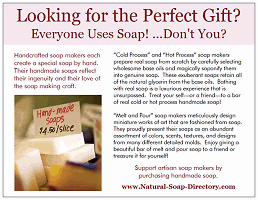

At the start of 2024, the US Average Consumer Price (ACP) for handmade soap was $3.59 per ounce. A 5-ounce bar of handmade soap is expected to sell for $17.95 (5 ounces × $3.59 average price per ounce = $17.95). As gas prices, inflation, and minimum wage increase, they drive consumer market prices higher. When soapmakers must pay more for ingredients, energy, and labor, they must charge more for the soap they sell. The Consumer Price Index and Producer Price Index track consumer commodities (including soap) and are reported by the US Bureau of Labor Statistics.

Will your cold process soap be cured in time to ship to customers for Christmas? Most people who purchase gifts online make their Christmas purchases from November 9 - 11, which is Veterans' Day weekend and several weeks earlier than "Black Friday." If your cold process soap takes five weeks to cure and dry, then you should have most of your Christmas soap made by early October (or sooner) to have the bars cured and ready to ship in early November.
Will you have enough soap ready to meet increased sales for Christmas? Most soap makers report their average monthly sales double for Christmas. To determine if you're ready, first figure your average number of bars of soap sold per month, which is the total number of bars sold in a year divided by 12 months. For example, if you sold 500 bars of soap last year, your monthly average will be about 42 bars because 500 bars per year ÷ 12 months = 42 bars per month. Next, multiply the average bars per month by 2. In the example, 42 bars average per month × 2 = 84 bars in projected sales for Christmas.
Will your soap be delivered to your customer in time? Soap must be shipped by Saturday, December 17, to guarantee it will arrive by Tuesday, December 24, 2024. If you ship Christmas soap later than Tuesday, December 17, caution the customer the soap may not arrive before Christmas and suggest expedited delivery solutions, such as Priority Mail Express®.
| S | M | T | W | T | F | S |
|---|---|---|---|---|---|---|
| 1 | 2 | 3 | 4 | 5 | 6 | 7 |
| 8 | 9 | 10 | 11 | 12 | 13 | 14 |
| 15 | 16 | 17 | 18 | 19 | 20 | 21 |
| 22 | 23 | 24 | 25 | 26 | 27 | 28 |
| 29 | 30 | 31 |
Remember, just as you're winding down from Christmas and feeling a sense of accomplishment, Valentine's Day seems to sneak up out of nowhere! Similar to the deadlines for Christmas (above), customers tend to make online Valentine's Day purchases during the Martin Luther King Jr. Day holiday weekend. Therefore, to have soap ready to be shipped during mid January, you must have made the cold process soap during the second week of December!

When making soap, accurate measurement is essential. Too little or too much of an ingredient can ruin the soap. Most soap makers agree it is a good idea to convert all ingredients to a consistent unit of measurement, such as measuring all ingredients in ounces or all ingredient in grams.
| From | To | Formula | From | To | Formula |
|---|---|---|---|---|---|
| Grain | Dram | gr × 0.0366 = dr | Dram | Grain | dr × 27.3437 = gr |
| Dram | Ounce | dr × 0.0625 = oz | Ounce | Dram | oz × 16.000 = dr |
| Ounce | Pound | oz × 0.0625 = lb | Pound | Ounce | lb × 16.000 = oz |
| Centigram | Grain | cg × 0.1543 = gr | Grain | Centigram | gr × 6.4799 = cg |
| Decigram | Dram | dg × 0.0564 = dr | Dram | Decigram | dr × 17.7184 = dg |
| Gram | Ounce | g × 0.0353 = oz | Ounce | Gram | oz × 28.3495 = g |
| Pound | Kilogram | lb × 0.4536 = kg | Kilogram | Pound | kg × 2.2046 = lb |
| Centigram | Decigram | cg × 0.1000 = dg | Decigram | Centigram | dg × 10.000 = cg |
| Decigram | Gram | dg × 0.1000 = g | Gram | Decigram | g × 10.000 = dg |
| Milligram | Gram | mg × 0.0010 = g | Gram | Milligram | g × 1,000 = mg |
| Gram | Kilogram | g × 0.0010 = kg | Kilogram | Gram | kg × 1,000 = g |
How much should you charge for a bar of your handmade soap? The most common mistake made by soap makers (and all crafters) is under pricing or not charging enough when selling soap. How can you be sure you've set a price high enough to meet all of your expenses and allow for a profit without over-charging? There are two formulas to determine how much to charge for a bar of your soap. Use the first formula to calculate the price of soap to be sold wholesale and the second formula to calculate the price of soap to be sold retail. Generally, wholesale pricing is used by soap makers who sell soap in large quantities or who sell soap to businesses that will re-sell the soap. Retail pricing is used by soap makers who sell their soap directly to the public.
{ (cost of ingredients for one bar) + (cost of labor to make one bar) + (cost of packaging for one bar) } × 2.35 = Wholesale Price for one bar
First, determine the entire cost of the ingredients for one bar of soap. In other words, how much did you have to pay for all of the ingredients to make one bar? Add together the cost for the amount of fat to make one bar, the cost for the amount of oil to make one bar, the cost for the amount of herbs to make one bar, the cost for the amount of colorants to make one bar, the cost for the amount of scents to make one bar, the cost for the amount of lye to make one bar, the cost for the amount of water to make one bar, and the per-bar cost for anything else that is in the soap. Do not include any labor or packaging costs, not yet.
Example:
1.30 ounces olive oil × $0.15 per ounce = $0.20 total cost per bar for olive oil
1.30 ounces palm oil × $0.11 per ounce = $0.15 total cost per bar for palm oil
1.12 ounces coconut oil × $0.09 per ounce = $0.11 total cost per bar for coconut oil
0.55 ounce lye (sodium hydroxide) × $0.36 per ounce = $0.20 total cost per bar for lye
1.29 ounces distilled water × $0.01 per ounce = $0.02 total cost per bar for water
0.03 ounces fragrance × $2.95 per ounce = $0.09 total cost per bar for fragrance
$0.20 olive oil + $0.15 palm oil + $0.11 coconut oil + $0.20 lye + $0.02 water + $0.09 fragrance = $0.77 cost of ingredients for one bar
Second, add the cost for the amount of labor to make one bar of soap. If you make 40 bars from each batch of soap, determine the amount of time to measure out ingredients, to make the soap, to cut the soap, to stamp the soap, to label the soap, and to wrap the soap; this equals the total amount of time needed to make and finish 40 bars of soap. Then, divide the total amount of time by 40 to determine the approximate amount of time per bar.
Example:
30 min to measure ingredients + 120 min to make the soap + 30 min to clean up the mess + 30 min to cut soap +
30 min to stamp soap bars + 60 min to label soap bars + 60 min to shrink-wrap the soap bars + 10 min paid break (labor law) = 370 minutes (6 hours, 10 min) of labor to make and finish 40 bars
370 minutes ÷ 40 bars of soap = 9.25 minutes labor per bar; always roundup, so 10 minutes labor per bar
Base the wages on minimum wage because if the soap business becomes a huge company, you will probably pay someone else minimum wage to do the labor. Only pay yourself the same amount you would pay someone else. (Note: 2024 Federal minimum wage is $7.25 per hour; most states are higher. Visit the US Department of Labor for more information.)
Example:
10 minutes labor per bar ÷ 60 minutes in an hour = 0.17 of an hour labor per bar
0.17 hour labor per bar × $7.25 per hour = $1.24 cost of labor to make one bar
Third, add the cost of packaging materials for one bar. Packaging materials include soap labels, ribbons, and decorations. Do not include any materials used for the purpose of shipping, such as bubble wrap or shipping boxes.
Example:
$0.10 label + $0.05 ribbon + $0.17 shrink-wrap material = $0.32 cost of packaging for one bar
Last, add the cost of ingredients for one bar, the cost of labor for one bar, and the cost of packaging for one bar. Then, multiply the sum of all costs per bar by 2.35 to determine the wholesale price.
Example:
$0.77 cost of ingredients for one bar + $1.24 cost of labor to make one bar + $0.32 cost of packaging for one bar = $2.33 total cost per bar
$2.33 total cost per bar × 2.35 = $5.48
Never round down, always round up $5.48 ≤ $5.49 Wholesale Price per bar
(Wholesale Price) × 2 = Retail Price
To determine the retail price of a bar of soap, first calculate the wholesale price (above) and then multiply the wholesale price by 2.
Example:
$5.49 wholesale price per bar × 2 = $10.98
Never round down, always round up $10.98 ≤ $10.99 Retail Price per bar

What is a profit and how much profit do you make per bar? Gross profit (also called "sales profit") is the difference between revenue (total sales) and the cost of production, before deducting overheads, payroll, taxes, or interest payments. Simplified, gross profit per bar is the difference between the total cost per bar and the sale price per bar.
Examples (continued from above):
$5.49 wholesale price per bar − $2.33 total cost per bar = $3.16 gross profit per bar (wholesale)
$10.99 retail price per bar − $5.49 cost per bar when purchased wholesale = $5.50 gross profit per bar (retail)
Successful businesses aim for a gross profit of 50%. To determine your gross profit per bar, divide the gross profit per bar by the sale price per bar.
Examples:
$3.16 gross profit per bar (wholesale) ÷ $5.49 wholesale price per bar = 0.5755 > 50% profit
$5.50 gross profit per bar (retail) ÷ $10.99 retail price per bar = 0.5004 ≈ 50% profit
This is a simple and very effective method to use to set up the price structure for your bars of soap. However, "gross operating profit" refers to the gross profit from all sales for a specified term. Also, further calculations must be done to determine operating profit, net profit (pre-tax profit), profit after tax, and retained profit. These types of profits require subtracting the cost of overheads, payroll, taxes, interest payments, and dividends.
Most soapmakers advertise, in some form, to sell their soaps. Handmade soaps are a special treat and are very enjoyable but most consumers habitually purchase commercial soaps at their local grocery store. Handmade soapmakers need to fight for their fair share of the soap market by educating the general public, by explaining why handmade soap is better than commercial soap, and by frequently reminding the general public.
It is the goal of the Natural Soap Directory™ to meet the needs of handmade soap makers by providing advertising for handmade soap, by educating the general public about the benefits of handmade soap, and by reminding people handmade soaps are better than commercial soaps. The Natural Soap Directory™ uses members' listing fees to purchase advertising space on Google and Yahoo, to print and mail thousands of postcards promoting the sale of handmade soap, and to print promotional stickers thanking people for choosing handmade soap.

A soapmaker should keep track of how much is spent on advertising the soap business throughout the year for a couple of reasons. First, the advertising expenses should not exceed the disposable advertising budget. Second, advertising expenses are tax-deductible when itemizing business expense for income taxes. A listing in the Natural Soap Directory™ is $72 per year, which works out to be $6 per month. At tax time, if you paid for a listing subscription and cannot find your receipt, please call us and we will be happy to email you a copy of your receipt.
Get a Natural Soap Directory™ Listing
Become a Natural Soap Directory™ member and let us help drive more traffic to your soap website. Happy soaping and the best wishes for success selling your soap!
Search for handmade soap, soapmakers, soap companies, glossary terms, soapmaking supplies, classes, events, and organizations.